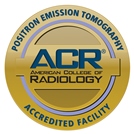Thyroid scans and uptake procedures begin with trace amounts of radioactive materials, which enter the body via radiotracers or radiopharmaceuticals. After the radiotracers are injected by IV or swallowed, a thyroid scan involves a camera to observe the organ’s shape, size, positioning and function.
The radioactive iodine uptake test (RAIU), informally called a thyroid uptake, does not involve imaging but uses radioactive materials to observe and measure thyroid function.
What Is a Thyroid Scan or Uptake?
Thyroid scans are a nuclear medicine imaging procedure where radioactive materials are used to diagnose a disease or evaluate thyroid function. Nuclear medicine provides noninvasive insights down to the molecular level, offering a degree of detail not possible through other imaging procedures.
As a result, radiologists are able to identify thyroid disease in its early stages, so a patient can receive proper treatment. Scans may further determine how well a patient is responding to a treatment plan.
For thyroid scans, a radiotracer includes a small amount of radioactive material that attaches to certain proteins within the body or gathers around areas with a high inflammation, such as a tumor.
A gamma camera or single-photon emission-computed tomography (SPECT) scan detects the radioactive material’s gamma ray emissions and images are displayed on a computer monitor. The images allow for a closer look at the thyroid’s structure and function, including its role within the body’s metabolic process. Images may be two or three-dimensional.
During a thyroid scan, the patient lies on a table below a gamma camera that sits on a gantry and rotates around the area being examined. The thyroid uptake does not create images, but still offers information on how the organ is functioning.
Due to the amount of detail provided, thyroid scans and uptakes often reduce the need for exploratory surgery but both procedures have a few risks. Although thyroid scans and uptakes have a low degree of exposure, patients have been known to experience a mild yet treatable allergic reaction to the radioactive material used. Pregnant or breastfeeding women should also avoid having this procedure.
Who Should Have This Procedure?
A doctor looking to examine the size, shape and location of the thyroid gland may request a scan, while uptake procedures are designed to examine thyroid function. Patients who’ve had or are currently undergoing treatment for thyroid cancer may benefit from a whole-body thyroid scan.
These tests allow a doctor to:
- See how well this endocrine gland is working
- Diagnose issues like hyperthyroidism, cancer or benign growths
- Gather detailed information about a nodule within the thyroid or unexplained inflammation
- Determine if thyroid cancer has spread outsole the thyroid
- Evaluate the effects of medication changes, surgery, chemotherapy or radiotherapy
Preparation
Patients should inform the technologist if they are breastfeeding, may be or are pregnant. Patients should also discuss other recent illnesses, medical conditions, allergies and medications, including supplements and vitamins containing iodine, kelp or seaweed.
The technologist should also be informed of any procedures involving iodine contrast dye undergone in the past four weeks, such as an X-ray or CT scan.
Prior to the procedure, patients will be asked not to eat or drink for at least 4 hours. You should also leave anything metal at home, such as jewelry or removable dental instruments.
Injection of the contrast material may involve a slight prick and initial cooling sensation, but thyroid scans and uptakes are virtually painless. In all cases, patients are advised to remain still throughout the entire procedure.
For the thyroid scan:
- The radiotracers will either be injected through an IV placed into your hand or arm at the time of the procedure or swallowed at least 24 hours before the exam.
- You will wait 15 minutes for the radiotracers to migrate to the area being examined.
- The camera will take images from three separate angles to ensure quality.
For the thyroid uptake:
- Patients are given radioactive iodine in a capsule form to swallow roughly 24 hours before the procedure.
- Uptake measurements may be taken 24 hours after the pill was swallowed.
- A stationary probe records information about the gland.
Following both procedures, the patient may return to standard daily activities. In the meantime, the radiotracers gradually deactivate and pass through the body. Over the next few days, it’s recommended patients drink extra water to move this process along.
After the radiologist and your doctor have reviewed the results, you may be asked to schedule a follow-up visit or additional testing.
Has your doctor recommended a thyroid scan or uptake? Contact us to make an appointment today!
















